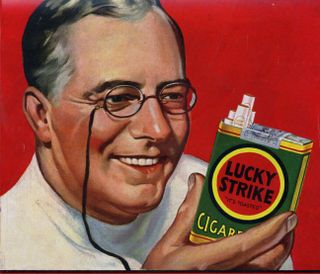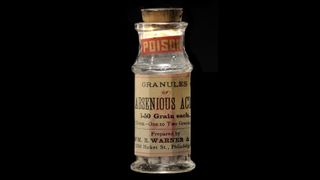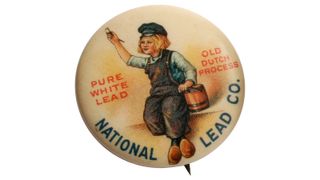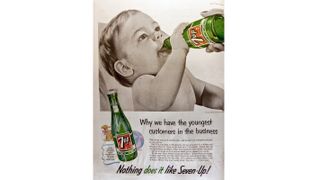13 Health Remedies We Can’t Believe Actually Existed
The path to effective medicines has not been without a false turn or two

Believe it or not, there was a time when heroin was considered a brilliant and effective cough medicine, so named because it made you feel heroic. Dabs of cocaine could be used to numb your child’s toothache, arsenic could right the effects of your sexual indiscretions and cigarettes made you look sexy while simultaneously curing your respiratory issues. Read on to find out what other preposterous health claims were made by 13 products that turned out to be really, really bad for you...
1. Cigarettes

Cigarettes, now notorious for staining your teeth and dramatically increasing your cancer options, were first sold by a man called Washington Duke who peddled pre-rolled smokes to Civil War soldiers from his farm in North Carolina in 1865. In the first half of the 20th century, cigs were seen as a cure for asthma, were often endorsed by doctors, and were promoted by the great stars of the time: film stars John Wayne and Betty Grable – who both died of lung cancer – and cartoon character Fred Flintstone. Science finally delivered the inevitable throat punch in 1965 when the proven link between smoking and lung cancer meant the tobacco industry was legally bound to include a health warning. Washington Duke’s success as a tobacconist, however, did lead to the creation of Duke University.
2. Parasites
Thanks to growing education, and the natural evolution of the human mind, we now know that the best way to diet is to eat sensibly and do some exercise. But as recently as the 1950s, people were known to deliberately feed themselves tapeworms in the hope that the creepy little parasites, which dine out on digestive tracts, would help to maintain a swimming-trunk-friendly body. Eventually, some appetite suppressants were found to be harmful and addictive, and became prescription-only. Broccoli, on the other hand, is still widely available.
3. Opium
Looking to relieve pain and irritation? Feeling nervously excited? Got a morbid irritability of body and mind? If this were the mid-1800s, you’d simply reach for Dr McMunn’s Elixir of Opium and you’d be right as rain in no time. And you’d also possibly be hooked on opium, which had been giving with one hand and taking away with about ten others since first referenced in 3400 BC. In Victorian society, it was commonly used to treat female patients who felt woozy or a bit down, and it was a favourite of Sir Arthur Conan Doyle’s famous fictional sleuth and wearer of interesting frock coats, Sherlock Holmes. Once its powers of curing depression were found to be bogus – they actually made it worse – its medicinal popularity waned.
4. Arsenic

A complex, indecisive element, arsenic was reportedly used by Emperor Nero to off his stepbrother Britannicus, then by numerous professional poisoners through the centuries – because it was almost undetectable, it was ideal for murdering people. Its popularity rose to the point where it was considered effective enough as a medicine to treat malaria and sleeping sickness in the form of Fowler’s Solution, invented by the British physician Thomas Fowler in 1786. The solution stretched its glowing credentials to boast a treatment for asthma, eczema, heartburn and some cancers, and is still used today as a medical treatment in some cases – thankfully only ever in small, non-murderous doses.
5. Electricity
It’s safe to say that electricity is now very much our friend: it heats our homes, boils our kettles and lights our lights. But for a period in the 1900s, it was given an even loftier position as the healer of erectile dysfunction in the form of Dr Sanden’s Electric Belt and Suspensory for Weak Men – which used electric jolts to stir the loins and cure their “nervous disability”. It has since been recognised that whipping off your dressing gown to reveal an electric belt attached to your private parts may actually result in the female equivalent of erectile dysfunction for your partner.
6. Lead

Lead was a very popular metal, and used to be found all over the place – in jewellery, food packaging, pipes, little fantasy figurines and, most notoriously, in paint, which was marketed as a great toy for children to play with while they waited for television to be invented. The paint had a sweet flavour that really spoke to infant taste buds, hence why so many of the poor little mites were stricken with lead poisoning. The League of Nations quite rightly banned lead-based paint in 1922.
Get the Coach Newsletter
Sign up for workout ideas, training advice, reviews of the latest gear and more.
7. Heroin
German chemist Heinrich Dreser of the drugs company Bayer deserves some gratitude for inventing aspirin, which has been treating headaches and fevers for years. However, he also invented heroin, which almost killed Zammo in Grange Hill and Bubbles in The Wire. It was introduced as a cough medicine and painkiller in the 1890s, with an extra benefit – according to Dreser – that it wasn’t habit-forming. That was until the early 20th century, when users began plundering scrap metal to fund their addictions – hence the term “junkie” – and in 1913 the company pulled its blockbuster product from the market.
8. Cocaine

In a hugely ironic twist, cocaine was used in dandruff treatments until the early 1900s, and it was also a known remedy for toothache among children and their suddenly wired parents. One US advert insisted that your Cocaine Toothache Drops (available for just 15 cents) were an “Instantaneous Cure!” – presumably for any humility problems you might be having. Cocaine began appearing in many products, but was quickly phased out in the 1920s when long-term users started showing signs of extreme arrogance and bad mental health.
9. Doughnuts
Brainchild of The Doughnut Corp of America in 1941, Vitamin Doughnuts promised “PEP and VIGOR”, thanks to “25 units of Vitamin B1” to help meet the needs of people during wartime. They would have got away with it, too, were it not for the unblinking faces they encountered at the War Food Administration.
10. Asbestos
Like so many things that seem too good to be true, asbestos – which was great for insulation – proved to be yet another surreptitious attack on human life. When it first rolled into town in the 19th century, spun in a method similar to cotton, it was all the rage on the fashion circuit (which absolutely LOVES new materials) before it eventually found a niche insulating schools, homes and places of worship. But only a cruel God would endorse such a dangerous product, which transpired to wreak absolute havoc on your lungs with fatal consequences. It was eventually outed as a hazard in the 1960s, and people basically ran up to their attics in a blind panic for the next 20 years.
11. Fizzy Drinks

These days, babies have three basic liquid options: breast milk, formula and plain boring water. It’s a no-frills situation that 7Up attempted to remedy in the ’50s with images of newborns downing fizzy pop with a tagline reading “Nothing does it like Seven-Up!” It even attempted to concoct non-alcoholic cocktails, mixing their drink with milk to make it even more baby-friendly. Thankfully, someone finally saw sense and the embarrassing campaign was sent to ad heaven.
12. Meth
In hindsight, we know that too much meth will hyper-age your face, leaving you looking not unlike a mummified Mother Teresa. It’s a cruel, restless drug that first surfaced around 1887 when a Japanese boffin discovered a chemical similar to adrenaline while toiling in his lab. In the mid-20th century it was marketed as Norodin, with the promise of relieving mild depression with zero consequences. It became popular with people looking to increase their energy levels and to stay alert, but as it happens there were massive side effects, including insomnia, heart attacks, even bigger bouts of depression and the aforementioned ugliness. Hence why Norodin is no longer available on the “Narcotics” aisle at your local chemist.
13. Morphine
Morphine – named after Morpheus, the Greek god of dreams – now trades only in professional environments among those who know how to use the stuff properly. Until 1930, though, you could nip to the local chemists in the UK and grab a bottle of Mrs Winslow’s Soothing Syrup, packed with pure morphine, to use as a cure for teething infants. Or to just take some yourself, no questions asked. Eventually, it was deemed a habit-forming drug that had no place in toddler circles – or society in general – and it was declared illegal, despite being considered a pretty decent treatment for “female hysteria”. Whatever that is.
This article appears in the latest issue of Coach magazine. To find out where you can get your copy, click here.
Coach is a health and fitness title. This byline is used for posting sponsored content, book extracts and the like. It is also used as a placeholder for articles published a long time ago when the original author is unclear. You can find out more about this publication and find the contact details of the editorial team on the About Us page.

